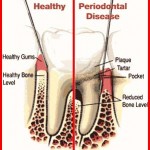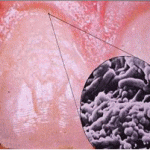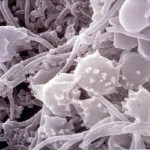Everyone’s feelings about their teeth are different; some people are better able or willing to follow a home care program than others. What we hope to do is give you a general description of how to remove plaque from your teeth at home. Without a doubt, the most effective way to learn the techniques is to have them demonstrated to you (ideally by your dentist or their assistant). All dentists prefer to have patients interested in prevention. It makes their job easier, and patients actively concerned with keeping their teeth healthy appreciate treatment more.
Plaque is the sticky, thin accumulation of bacterial products from food and saliva that grows in the mouth, adhering to teeth, gums and tongue. To prevent decay, it must be removed from the places (warm, wet and dark) where it grows best—in the crevice where the tooth and gum meet (the sulcus), between the teeth, and in the grooves of pre-molars and molars. Plaque left undisturbed for a period of time calcifies and hardens, becoming calculus or tartar, which has to be removed professionally—you cannot do it by yourself at home.
Plaque forms continuously. For example, two hours after your dentist or hygienist has cleaned your teeth, even before eating, plaque starts to form again. Within eight hours, it starts to deposit on the teeth, and in twenty-four hours, it is “organized,†adhering to the teeth and potentially dangerous to dental health. That, in short, is why teeth must be cleaned for two minutes twice per day, everyday.
Accumulation of plaque causes the gums to bleed, become tender, and swell—it’s like having an enemy in your mouth. The real danger of plaque is when it burrows under the gums, where it can tear the fibers that attach the tooth to the gum and finally the bone that supports it. Eventually, untreated plaque affects the bone itself, which literally melts away since it is no longer protected by fibers.
Plaque that forms on the surface of teeth can cause cavities. Once it adheres to the surface, nothing unites as rapidly with plaque except refined sugar. The combination of plaque and refined sugar forms an acid that bores into the enamel and provides nourishment for decay-causing bacteria. During the day, saliva acts as a detergent and helps neutralize the acids on the teeth (we swallow about two thousand times a day). However, when we sleep, we swallow only about twenty times, and any plaque that is left in the mouth when we go to bed has plenty of time to work undisturbed and propagate. This is why plaque must be thoroughly removed every night after your last meal or snack.
The program of home care most widely recommended (besides brushing after meals) is the critically important thorough cleaning before going to sleep at night. Investing ten minutes or so at the end of the day to clean your teeth correctly may prevent uncounted hours in the dentist’s chair.
Equipment. People always pack a toothbrush when they travel; and when they forget to do so, are unsettled. A toothbrush is part of our lives, and should be, since it is essential to good home care. Although we don’t often think about what kind to buy, there are differences, and important ones. Not long ago, the hard natural bristles had almost knife-like tips that could cut the gums and, when used to remove plaque under the gums, could break and create an irritation in the area. Consequently, more and more dentists are recommending the soft, multi-tufted nylon brushes with rounded bristles. These are ideal for plaque removal. These bristles won’t break under or irritate the gums. When properly used, the many bristles loosen the plaque and scrub it away. This does not mean that the multi-tufted brush is the only one to be used, it means that it is the best one for plaque removal. When choosing a toothbrush, look for brushes with bristles that form a 45 degree angle. This particular angle, allows you to remove the plaque from the area between the teeth and gums where it is hardest to remove, but quickest to propagate. If your dentist suggests a brush for you, use it, as he or she knows your condition and what is in your best interests.
Besides a toothbrush, you need dental floss. Many types are available, we prefer unwaxed (unbounded) nylon floss, made of thin nylon filaments that separate when used and can consequently better remove plaque. Waxed dental floss is also effective and there are tight contacts between teeth, it gets through them more easily. However, the waxed nylon may glide over minute plaque areas that the unwaxed filaments can pick up.
Disclosing solution or tablets (which, like toothbrushes and dental floss, can be bought at almost any drugstore) are coloring dyes used to uncover the difficult-to-see plaque. If the teeth are clean, it washes them off harmlessly, but when plaque is present, the coloring material sticks to it and exposes (discloses) the harmful bacterial deposits that must be removed.
Most dentists will recommend one of the ADA-approved fluoride brands of toothpaste, particularly for children. However, with children who actively dislike toothpaste of any sort, it’s more important to insist that they brush properly rather than insist their using a toothpaste that might discourage brushing. Dentists often recommend specific toothpastes for specific situations. A desensitizing toothpaste can be suggested for a patient with sensitive teeth (certainly if decay is the cause, this would be treated first.) A whitening toothpaste may be suggested for someone whose teeth stain easily, for a heavy smoker, or for someone whose bonded teeth darken. Your dentist will always tell you how frequently to use it.


